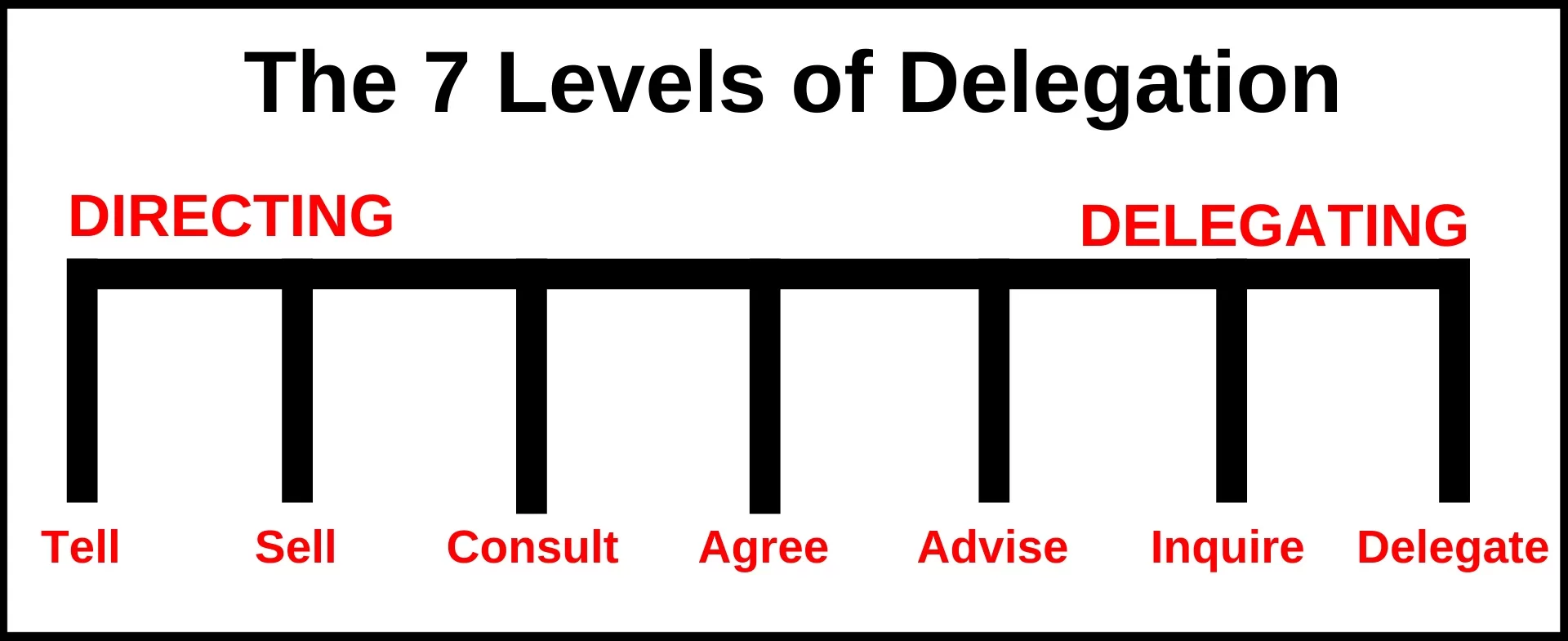The Complete Guide to Delegating Work Like a Pro
I’ve always known delegation is important for leaders, but its importance really sunk in when I saw two leaders almost lose their marriages from failing to delegate work.
It happened almost a decade ago. Two client service leaders who reported to me — let’s call them Greg and Derrick (pseudonyms) — called me into a conference room to chat.
I knew they’d both been feeling overworked, but I didn’t realize how bad it had gotten until Greg started crying.
“I just can’t do it anymore, Bobby,” he said. “Supporting this client is killing me, and I feel like I’m never home with my family anymore.”
Then Derrick chimed in.
“Yeah, my wife just threatened to leave me last week,” he said. “I’m not getting much time with her and the kids because I’ve been working so many hours.”
Hearing their story crushed me. I value work/life balance, so I strive to work 40-hour weeks and I want my team to do the same. But what really killed me was that we had been trying to get Greg and Derrick to delegate work for months.
And for months, they had refused.
They didn’t trust anyone else on the team to do the work. I could understand why (at least a little) because the client they supported was complex and demanding. They had a capable team, but they knew that any mistake could push their client over the edge, so they decided to do everything themselves.
The result was late nights, nonexistent weekends, oodles of stress, and (apparently) two nearly-broken marriages.
This problem happens A LOT
I’ve trained dozens of early-career leaders over the years, and nearly every one of them has struggled with knowing what and how to delegate.
Even though delegation is a difficult skill to learn, it’s a crucial tenet of leadership.
Delegation is not merely a tactic to minimize your workload; it’s one of the most effective ways to develop and improve your people.
Although it’s natural to worry about burdening your team by giving them more work, many inexperienced managers don’t delegate enough. You can often tell whether you’re delegating enough by evaluating what type of work you’re completing and how much you have on your plate.
For example, if you keep canceling meetings or postponing important projects, that’s a sign you’re taking on too much responsibility.
Or, if you recently got promoted into a manager role and you find yourself still doing 50 percent of your old tasks (e.g., writing the same reports, attending the same meetings) instead of passing that work off to others, you may need to delegate more of those tasks to your team.
Why leaders struggle to delegate
There are many reasons why you may struggle to delegate certain tasks. I’ve listed five common reasons below, along with a short rebuttal or reframe of each.
Reason #1: You think you can do it better yourself.
Rebuttal: Maybe you can, but at what cost? If someone else can do that task 80 percent as well as you can, that may be good enough.
Reason #2: You don’t trust anyone else to do it.
Rebuttal: This could be a red flag that you haven’t developed capability within your team. As a leader, your job is to develop your people, so if no one else can do that task, you should quickly work to develop your team’s competency in that area and ensure you’re not siloing knowledge.
Reason #3: It’s easier to do it yourself.
Rebuttal: Sure, maybe it would take a long time to teach someone that task, but how often does this task arise? If it needs to be done weekly or monthly, then teaching someone else how to do it will likely save time and make life easier in the long run. Plus, it will potentially help the other person learn a new skill.
Reason #4: You worry your people are too busy.
Rebuttal: Everyone is busy, including you. Sometimes the only way for you to avoid long hours and burnout is to delegate more. If you’re concerned your team members may have too much going on, just ask what else is on their plate and use that info to prioritize and delegate accordingly.
Reason #5: You aren’t sure what to delegate.
Rebuttal: There’s no formula for what to delegate, so try asking yourself a few questions to determine whether delegation is the right decision in a particular situation: Is this task a core element of my job? Is this something I’m uniquely able to handle or could someone else learn it? Am I the only person who could do this or simply the best person? Could a team member grow by taking on this opportunity?

Remember: the primary purpose of delegation is not to get rid of your own work but to develop your team and find opportunities for them to grow.
Delegation helps distribute work, develop the skills of your team, break down silos of knowledge, and free you up for other strategic initiatives. It’s a long-term investment in your team and the company.
The 7 levels of delegation
When most leaders think of delegation, they just think of delegating tasks, but you can (and should) also delegate decisions.
When you delegate a decision, you’re trusting someone else to make that decision on your behalf, or — at the very least — letting them suggest a potential solution.
Each business situation is slightly different. Some decisions are best made by you, while others are best made by those on your team. Delegation is not always appropriate, and you may decide to delegate certain aspects of a project but not others.
For example, a Customer Success Manager (CSM) may decide to delegate a project to collect customer data but may want to be one of the key decision-makers to determine what action steps to take based on the data collected.
One of the most effective delegation models I’ve found is The 7 Levels of Delegation, which has been written about by entrepreneur Jurgen Appelo and other leaders:
- Tell: You make the decision yourself.
- Sell: You decide which decision you think is best, then sell others on your idea.
- Consult: You ask for input before deciding and try to consider other people’s opinions in your decision.
- Agree: You discuss the decision with everyone and seek group consensus.
- Advise: You allow others to decide, but you offer an opinion for them to consider.
- Inquire: You let others decide but ask them to sell you on their decision afterward.
- Delegate: You leave the decision entirely up to someone else and tell them they don’t need to follow up with you.

To determine which level is appropriate for a given situation, ask yourself the following questions:
1. How quickly do we need to move on this decision?
When speed is of the essence, you’ll likely want to choose one of the “Directing” levels on the left-hand side of the chart. For example, it’s often best to choose “Telling” or “Selling” in times of war, crisis, or emergency.
On the other hand, if there’s limited urgency, you might opt for the “Delegating” side of the chart: trust someone on your team to determine what has to be done.
2. How important is this decision and how many people will it impact?
The greater the importance and impact of a decision, the more certain you want to be. You’ll likely want to choose an option toward the middle of the chart that incorporates many people’s ideas.
People like to have a say, so it’s beneficial to allow others to have a stake in the decision-making process whenever possible.
3. Is this decision a one-way door or a two-way door?
Jeff Bezos has discussed this concept in interviews and shareholder letters. One-way door decisions are final — they’re almost impossible to reverse. Two-way door decisions allow you to make an initial judgment, then later revert it.
As you probably suspected, you should lean more on the “Directing” side for one-way doors and more on the “Delegating” side for two-way doors.
4. Can one or two other people learn something from making this decision?
By picking an option on the “Delegating” side of the chart, you can give others a growth opportunity by letting them make the call.
Regardless of how a decision is made, you must fully own it and be accountable for it. That means that if you’ve delegated the decision to someone else, you should not throw them under the bus if it doesn’t work out.
As the leader, you are responsible for the decision.
How to delegate effectively
“Never tell people how to do things. Tell them what to do and they will surprise you with their ingenuity.” -General George Patton
Delegation is a difficult skill to master. Here are a few tips to keep in mind when delegating work:
- Use the 80% rule. If someone else can handle a task or decision at least 80 percent as well as you can, that may be good enough — especially for small tasks and non-client-facing work.
- Delegate meetings too. The higher you climb up the ranks of a company, the more meetings you’ll be invited to attend. For some of them, the best way to say “no” is to send a proxy who can voice the interests of your team or department. (The 80% rule applies for meetings too.)
- Identify the right person. Pick someone who can learn from the activity you’re delegating, yet still has the skills to accomplish the task.
- Define the WHAT and the WHY, but delegate the HOW. Share the relevant background information so they know why the task is important. Then let them decide how to do it.
- Define what “done” looks like. Talk to the person and agree upon a shared definition of what “done” looks like for the project. For example, should the final deliverable be saved in a PowerPoint presentation, a Word document, or an Excel spreadsheet?
- Clarify who owns what. Using the lens of “The 7 Levels of Delegation” model above, explain your expected level of involvement in the project. Do you want the team member to run their idea past you before they act? If so, tell them. Setting expectations upfront ensures everyone is on the same page.
- Find the balance. If you delegate something and continue to stay heavily involved, they may feel like you don’t trust them. But if you completely disconnect and never check in with them, they may think you’re disengaged and unwilling to help. Ask what you can do to support them and how they’d like you to be involved.
- Agree on a timeline. When should this project be completed? Is there an external date you need to hit from a client, partner, vendor, or company executive?
- Determine project milestones. If the project is large and complex, it may be helpful to determine a few milestones. Those will not only chunk the work into smaller tasks but also give you a few agreed-upon touchpoints when you can check in with the team member without feeling like a micromanager.
Delegation is a skill that can simultaneously expand your capacity and develop your team’s capability.
Use these tips to avoid late nights, long weekends, and fractured relationships. 😉




